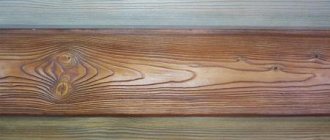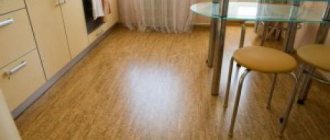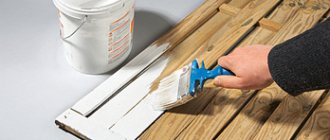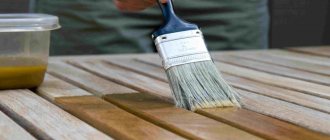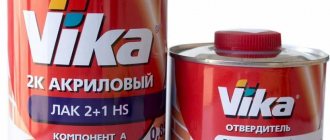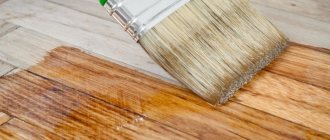Water-based compounds
Sold in both powder and liquid form. Powder impregnations are prepared independently: the powder is mixed with water in appropriate proportions. In this case, the shade that the tree will receive largely depends on the ratio of liquid and powder mixture in the resulting solution. Most consumers prefer liquid impregnations that are completely ready for use.
The main advantage of water-based stains is that they have virtually no odor and do not emit any toxic compounds during application or drying. Therefore, such products are most often chosen for interior work in residential premises. In addition, water-based impregnations perfectly emphasize the texture of wooden surfaces, and at the same time hide pronounced fiber defects quite well. This type of paintwork material dries completely in 12-15 hours.
Water-based stains also have disadvantages. Firstly, they poorly (in comparison with other means for staining wood) protect the surface from abrasion and mechanical stress. Secondly, they are less resistant to high humidity. After applying the composition, the surface becomes rough - this is the reason for the reduced moisture resistance. Therefore, if the wood will be used at high humidity levels, it is stained with aqueous compounds in two stages. After applying the first layer and its complete drying, the working plane is carefully sanded. Then they clean it from dust and spray it with water. Then you can begin finishing painting.
What is stain used for?
Wooden external and internal walls, outdoor and indoor flooring, furniture, doors, windows, decorative items, kitchen utensils and dishes are subjected to artificial staining. First of all, this technique is intended to change the shade of wood.
There are also additional functions:
- protection against wear and damage under the influence of unfavorable external factors (precipitation, sunlight, fires, insect pests, putrefactive microorganisms, mechanical damage, such as abrasion by feet in the case of parquet);
- restoration of products, leveling of color, returning the original gloss and depth of color;
- giving inexpensive wood a resemblance to noble varieties, and sometimes complete imitation (there was alder, but the result was beech or hornbeam);
- emphasizing the beautiful natural structure and unique pattern of wood.
Acrylic-based compositions
Acrylic stains are produced only in the form of liquid mixtures. They come in a wide variety of colors. If necessary, the desired shade can be easily obtained by mixing compositions of different color palettes with each other. These stains have good performance characteristics in all respects. They do not emit volatile toxic substances and do not emit an unpleasant odor. In addition, the compositions provide reliable protection of wood surfaces from moisture/water. Also, acrylic impregnations form an even film after application and dry very quickly. They have only one drawback - the high price.
Gel-like stains
In Russia, the building materials market offers stain-gel from foreign brands. They work with it with special tampons. It is recommended for soft wood to harden its surface.
They work inside buildings, outdoors. Wooden items and high-traffic floors are tinted.
On a vertical plane, the gel material does not spread and lies evenly. The covering power of thick materials is 2 times higher than that of liquid materials. There is no problem with the warp fibers lifting.
Tip: The gel on the surface creates an imitation of the texture of natural wood.
The coating dries quickly. The second coating is applied 2 hours after applying the first.
Every year manufacturers expand the range of this group. Today the choice is limited to a small number of compounds. They are considered expensive finishing coatings. Varathane Pemium Gel Stain (tinting gel for interior and exterior use). 0.946 l for 1849 rubles, consumption: 19-23 m2 per 1 l. and is dictated by the porosity of the wood, USA.
Oil-based formulations
This type of stain has been used to protect wood for a long time, and still continues to be popular due to its optimal quality/price ratio. These products are made on the basis of oils that are environmentally friendly. Oils penetrate deeply into the structure of wood, which ensures high-quality and long-term protection from moisture and mechanical stress. Wood treated with this impregnation almost does not fade in the sun and retains its color for a long time. Most often, oil stains are used to coat furniture. The drying time of the impregnation is approximately 3 hours.
What it is?
Stain is a liquid product that is applied to a previously prepared wood surface, penetrates into the upper layers and, after drying, changes its color and properties.
The stain consists of a coloring pigment and base, optionally equipped with protective components: against fungi, insects, ultraviolet radiation, humidity, fire. The product was invented in the city of Cologne and throughout the world, including our country, and was originally called “beitz” from the German word for “dye.”
Current beyts can be purchased in the form of a ready-made solution, powder or concentrate for dilution. The higher the concentration, the richer the shade. Application in several layers allows you to enhance the effect, and finishing varnish, oil and wax coatings help to consolidate the result.
Wax-based compounds
Wax stains appeared on the mass market relatively recently, but have already proven themselves well. These formulations do not contain water. They are applied to the tree superficially, without penetrating into its structure. Wax mixtures form a continuous protective film on the surface. Typically used for external work. Most often, wood is treated with wax before applying various types of paints and varnishes. The wax completely seals the wood pores, which ensures uniform application of paintwork materials and their economical consumption. Wax compositions should be applied using soft and completely dry tissue swabs. This eliminates the formation of stains and makes it possible to create a continuous wax film with a high degree of moisture resistance.
Assortment of colors
Each brand has its own line of colors for decorative and protective material. Among the variety of shades, the basic colors that are in the catalog of all manufacturers are highlighted.
Furniture and interior finishing materials are covered. Used to expand space and add light to the room.
White color
The door leaf and its frame are decorated. Oil stain is most often chosen. Floors are covered with it, because a protective layer resistant to abrasion will be obtained. Black is used in the compositional design of the interior.
Black color
The classic interior is decorated with dark brown wood with veins and splashes of black. This is the color “Wenge”, used for accessories on furniture, on doors, applied to floors, panels.
Color “Wenge”
"Mahogany" is the color of expensive wood. It is cast in shades of red and brown. Used in both classic and modern styles, on any wooden products.
Color “Mahogany”
A combination of silver, grey, blue, black - “Ebony”. The color is applied to polished hardwood. The floor, panels, and pieces of furniture are covered with stain.
Ebony color
Blue stain (“behandla”) is in demand for furniture in children’s rooms and kitchens. Often used in combinations with white, gray, yellow, and blue.
Behandle color
“Mahogany” is a light shade compared to “wenge” and “mahogany”, but it does not look as respectable. It is not recommended to use aggressive red in rest rooms, or to overload other rooms with it. This should be an accent color. For example, a red wooden table in the dining room.
Color “Mahogany”
Too much gray can make a room look gloomy, but delicate use will add personality and neatness to the interior. It is recommended to combine it with bright colors.
Color “Grey”
Shades of green contribute to a person’s relaxation, so they are used in bedrooms, in the living room, in the room of a little naughty boy. Wood with a green coating should be in harmony with the style of the room.
Green color"
In hallways, corridors, living rooms and bedrooms, the noble shade of “walnut” is often used. It can be applied to any wood in the interior, except for the ceiling. The natural grain of the wood is emphasized.
Color “Walnut”
Alcohol-based formulations
They are sold in the form of powders and fully prepared liquid solutions. During the processing of wood, only pigmenting additives are absorbed into it, and the alcohol/solvent evaporates without leaving a residue. It is for this reason that alcohol impregnation takes about 30 minutes to dry. Fast drying is both a plus and a minus of alcohol stains. The fact is that the surface needs to be processed quickly - otherwise unevenly painted areas may appear on it, which will be noticeable. Only an experienced painter can apply this type of wood impregnation by hand. In general, it is much easier to work with it using spray guns.
Surface preparation
Before processing an outdated wooden part, updating a door leaf, or simply changing the color of the back of a chair, you need to:
- Completely dry the surface we will be working with.
First, the surface is treated with coarse sandpaper, after which it is cleaned with “zero”
- We sand using sandpaper - do not press on the surface and direct movements exclusively along the grain.
- Using a vacuum cleaner, remove the accumulated dust from the surface.
- We degrease the wood using alcohol or a special solvent.
- We apply stain.
For the work process we use a brush, roller or foam sponge (in cases where we have to deal with small products)
Interesting! Before applying the solution, lightly wet the surface, this will help the stain (regardless of its type) to adhere better.
Color palette
The stain is absorbed into the outer layer of the wood surface. It colors the material non-uniformly, depending on the density of the fibers. Thanks to this, the natural texture of the wood is completely preserved. If previously wood stain could only be used to darken wood, now various compositions make it possible not only to lighten wood, but also to convey various, including rich, shades to it. Color saturation depends on the following factors:
- species and original shade of wood;
- porosity;
- density;
- textures.
In terms of color palette, modern stains practically do not differ from high-quality paints
The same composition can color different types of wood differently. For example, after treatment with nitro stain, oak will become dark brown, and maple will become yellowish. It should be taken into account that coniferous species absorb stains less well and unevenly. Therefore, before processing, it is necessary to carefully remove the resin from the surface and coat the product in two layers.
Correcting possible errors
Unlike paint, defects resulting from wood stain treatment are extremely difficult to remove. Therefore, when applying, it is necessary to carefully follow the work procedure and be extremely careful:
- if grout has formed as a result of applying stain, it is necessary to remove it as quickly as possible using a dry cloth;
- if the applied finish has already set, but has not yet completely dried, then a second layer is applied to the treated surface, and then both are removed with a piece of cloth;
- if the stain is completely dry, then you will have to use a solvent in combination with abrasive sandpaper;
- When using a highly pigmented stain, the only solution is to remove the outer layer using a plane.
Video: correcting stain defects
Consumption
The stain is well absorbed into the wood. In addition, when purchasing the required amount of finishing material, it is necessary to take into account the porosity of the base. As a rule, 1 liter of ready-made solution is enough to treat 12-15 m². However, the method of application and the type of building structures should be taken into account. For example, when applying stain from a spray gun, the diameter of the nozzle and pressure are of great importance. The optimal option for aqueous solutions is 1.5 mm at a pressure of 3 atm, and for alcohol and nitromortars - 1.3 mm at a pressure of 2-2.5 atm. The stain should only wet the surface being treated and not sit there in puddles.
Penetration of stain into the wood structure
Useful tips
Let's look at some important tips:
- Do not apply the composition in the cold. Stain adheres very poorly to a wooden surface at low temperatures, so you will get uneven toning.
- If you are working with coniferous wood , then after removing the old paint/varnish you need to deresin the wood. Mix 100 g of acetone and 400 g of water, cover the surface of the wood with the mixture, rinse it off after 30 minutes and dry the wood.
- If you want to get a light cherry color of wood , then instead of stain you can use potassium permanganate for impregnation. Dissolve 50 g of potassium permanganate in 1 liter of water, saturate the wood with the mixture in 2 approaches.
In conclusion, I would like to note that when choosing a stain, you should not skimp. People usually buy cheap water-based compounds, but they need to remember that they are only suitable for finishing wood inside the house. If you want to tint outdoor wood structures or expensive items, be sure to buy acrylic, oil or wax stain. Let you pay an additional 600-700 rubles, but the effect of tinting will last for many years.
Wood stain video
Manufacturers
Stains are produced by the same companies that produce paints and varnishes. Among the most well-known manufacturers whose products enjoy deserved popularity are the following:
- Germany: Flamingo, Dufa, Caparol;
- Türkiye: Betek, Dyo, Marshal;
- Slovenia (Belinka Belles) - Belinka trademark;
- Finland - Tikkurila;
- France - Liberton;
- KANSAI PAINT group – international trademark Helios;
- AkzoNobel international corporation - DULUX trademark.
Reviews
Dufa Wood Protect stain Lazur Belinka stain Tikkurila Pirtti stain Liberon Black Bison stain Dulux Woodshen stain
Features of choice
First of all, it is necessary to select the composition of the stain based on the area of use. They, like other paints and varnishes, are divided into two main groups: internal and external.
Manufacturers provide a wide range of stains with different performance characteristics and color options.
Each type of wood has a different structure, which determines the possibility of painting it. You should not try to stain coniferous wood with an intense color using stain. You can get spots of different pigmentation on the surface. It is advisable to lightly tint coniferous species. On the contrary, hardwoods absorb moisture well. Consequently, a wide variety of coloring compositions can be used.
